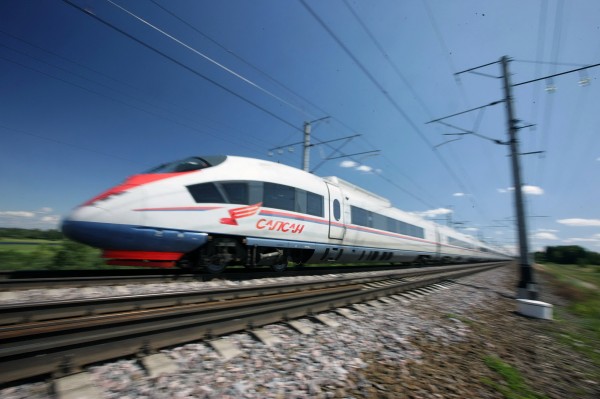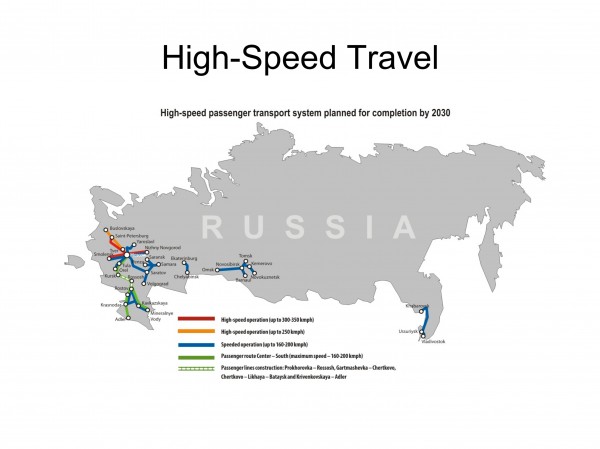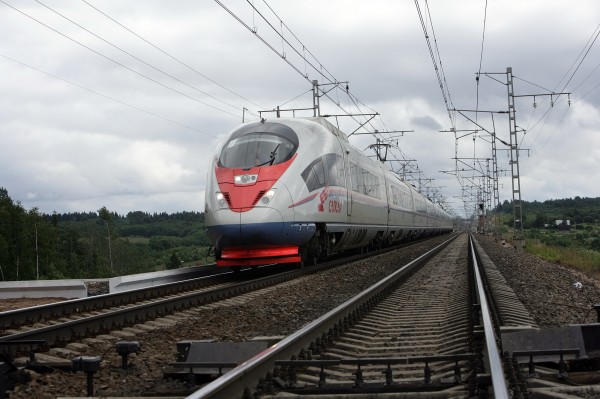Developing high-speed rail transport in Russia
Posted: 4 August 2010 | | No comments yet
The changing economic situation in Russia, and the increase in business and transport activity among the country’s population in recent years, served as an incentive to draw up the Programme for the Development of High-Speed and Very High-Speed Transport, as part of the Strategy for Developing Rail Transport in the Russian Federation up to 2030, adopted by the Russian government in June 2008.
The company is confident that the implementation of this programme will allow it to position rail, in the passenger transport sector, as a competitive service able to provide a high-quality transport product for the Russian population, while yielding profits for the company.
The changing economic situation in Russia, and the increase in business and transport activity among the country’s population in recent years, served as an incentive to draw up the Programme for the Development of High-Speed and Very High-Speed Transport, as part of the Strategy for Developing Rail Transport in the Russian Federation up to 2030, adopted by the Russian government in June 2008. The company is confident that the implementation of this programme will allow it to position rail, in the passenger transport sector, as a competitive service able to provide a high-quality transport product for the Russian population, while yielding profits for the company.
The changing economic situation in Russia, and the increase in business and transport activity among the country’s population in recent years, served as an incentive to draw up the Programme for the Development of High-Speed and Very High-Speed Transport, as part of the Strategy for Developing Rail Transport in the Russian Federation up to 2030, adopted by the Russian government in June 2008.
The company is confident that the implementation of this programme will allow it to position rail, in the passenger transport sector, as a competitive service able to provide a high-quality transport product for the Russian population, while yielding profits for the company.
The main focus of the programme is organising high-speed and very high-speed services in seated carriages offering comfortable travel with journey times of 6 to 7 hours.
To provide high-speed and very highspeed transport, Russian Railways purchased eight high-speed Velaro RUS trains from the German company Siemens, which operate in Russia under the Sapsan brand – the Russian name for the peregrine falcon, the world’s fastest bird.


In December 2009, a high-speed service was launched on the Moscow to St Petersburg line, with maximum train speeds of 250km/h. The minimum journey time is 3 hours 45 minutes, compared to the average journey time for normal passenger trains on this route of 8 hours. The average journey time from Moscow to St Petersburg by air (taking into account travel to and from airports, flight registration, and flying time) is not less than 5 hours.
Each month, the Sapsan trains are used by more than 125,000 passengers. Due to the high demand for the service, the company has timetabled six daily journeys from Moscow and St Petersburg.
In 2010, the range of the high-speed Sapsan electric train’s operations will be extended to Nizhny Novgorod and work is also progressing on launching high-speed trains on the St Petersburg to Helsinki route.
On the basis of an international tender to acquire trains for this route, a contract was signed in September 2007 with the French firm Alstom for the provision of four Pendolino-series trains.
Together with Finland’s state railway company, we plan to arrange four daily return journeys (four departures from St Petersburg and four from Helsinki). The trains will operate under the name Allegro.
We expect to launch the first trains at the end of 2010. The maximum train speed will be 220km/h. The launch of high-speed services on the St Petersburg to Helsinki route will allow journey times to be reduced to 3-3.5 hours, compared to the current 6 hours. The journey through Russian territory is planned to be reduced by 2 hours 27 minutes.
Looking ahead to 2015, and considering current and potential passenger flows, the priority route for creating a high-speed passenger transport service was designated as Moscow–Tula–Oryol–Kursk, extending to Belgorod. According to preliminary studies, the total cost of the project could be almost 142 billion rubles. This project represents the first stage in organising high-speed passenger services on the Centre–South (Moscow–Adler) route, with the use of the Kursky line of the Moscow Railway.
As well as the Moscow–Kursk route, the list of priority lines for organising high-speed passenger transport also include Moscow–Yaroslavl and Moscow–Krasnoye (on Russia’s western border), later extending to Minsk, Brest, Warsaw and Berlin.
Also, to provide high-speed passenger services linking Russia to Germany and Poland, plans are currently being considered to create a passenger line on this route with rolling stock featuring variable-gauge wheelsets, using Spanish Talgo carriages, which will enable the integration of high-speed networks in Russia and the European Union.
Rolling stock for high-speed passenger transport on priority routes has yet to be chosen. Russian Railways is looking for potential partners for the production of a new model range of rolling stock, as a principally new type of multiple unit is needed. As far as rolling stock for very high-speed routes is concerned, an international tender will be held, where we will see proposals from global producers of modern trains.


As well as the European part of Russia, Russian Railways is currently looking into developing high-speed passenger services to the Urals and Siberia. In particular, work is underway on assessing the cost of work needed to develop the railway infrastructure of the Novosibirsk–Omsk and Sverdlovsk–Chelyabinsk lines.
Potential high-speed passenger train flows on these routes would be from one to three train pairs per day. The journey time reduction could be, depending on the route and maximum speed, from 1 hour (Novosibirsk–Barnaul) to between 4 and 6 hours (on the Novosibirsk–Omsk and Vladivostok–Khabarovsk lines) in each direction.
In mid-March 2010, Russian President Dmitry Medvedev signed a decree on measures to establish high-speed rail services in Russia. Russian Railways was designated the natural party to fulfill the role of ordering infrastructure projects for high-speed rail transport.
The Moscow–St Petersburg line was chosen for the first project to build a very high-speed route, with a journey time of 2 hours 30 minutes, and a projected annual passenger count of 14 million people.
This project is revolutionary for Russia. In carrying it out, a method will be used that was previously unfamiliar to this country – contract lifecycle management – with a public-private partnership mechanism and the holding of an international tender.
This mechanism foresees the involvement in the project of the government and investors with international experience in the construction and running of very high-speed lines.


The Sapsan trains are used by more than 125,000 passengers each month
As international experience illustrates, the route to the major possibilities offered by both high-speed rail and contract lifecycle management is fraught with highly expensive mistakes and disappointments. The only way to avoid them is to attentively learn from the experience of countries that have already carried out such projects. Russian Railways is attracting European colleagues from countries such as Portugal, France and the Netherlands, who have taken part in and personally led projects to create HSR under CLM schemes for their governments, which gives us the possibility of looking at and evaluating their experiences from the point of view of the government.
As the project to build HSR on the Moscow–St Petersburg route is of national significance and is a high-expense project for Russian Railways, its implementation is possible only through financing from the government. Russian Railways’ additional proposals on the scheme for implementing the project and state involvement in its financing will be presented by the company after ongoing work on a contract lifecycle management plan is completed.
As well as the Moscow–St Petersburg line, the maximum option under the Strategy for Developing Rail Transport in the Russian Federation up to 2030 foresees the creation of a very high-speed passenger route on the Moscow–Nizhny Novgorod line, and also on the Centre–West line (Moscow–Minsk–Warsaw–Berlin).
We realise that with the launch of a separate high-speed route, the issue of rail transport security will become even more important. A range of measures are currently being developed to improve travel security, primarily on the Moscow–St Petersburg line. These include both modern technical devices to detect unauthorised access to the railway infrastructure, and an increased number of contract security guards on the transport network.
Under a decree signed by the Russian president in March, work is to be stepped up and systems put in place to create a regulatory and technical base for organising high-speed services, and a range of priority measures are to be established, defining acceptable financing mechanisms. The first step in carrying out this decree will be to establish a technical regulation ‘On the Security of High-Speed Rail Transport’, which will set requirements for security on high-speed railway transport and set out the basic requirements for high-speed infrastructure and rolling stock.
The need to develop this document is due to the current lack in Russia of statutes legally regulating security on high-speed rail transport. The currently applicable documents of the State Committees for Construction of the Soviet Union and Russia, and of the Russian Transport Ministry, do not extend to railway transport with track speeds of over 200km/h.
In conclusion, I would like to stress that railway transport is a fundamental component of the socio-economic setup and defense capability of the nation, and a guarantor of the constitutional right of citizens to freedom of movement. The state and development of Russia’s rail network has a direct bearing on the perspectives for the national economy’s growth, the protection of national sovereignty, and the maintenance of a unified socioeconomic space.
Increasing travel speed is an objective requirement for the development of humanity, and a component of scientific and technical progress. Speed has always been an indicator of the development of transport, road and rail networks, and rolling stock, and to a significant degree the level of engineering, technical and economic development of society. Turning Russia into a country with a high-speed rail system is therefore one of the most important goals of Russian Railways.
About the Author
Vladimir Yakunin
Vladimir Yakunin was appointed President of Russian Railways by the Government of the Russian Federation in June 2005.
Mr. Yakunin graduated from the Leningrad Institute of Mechanics as a Mechanical Engineer in 1972 and began his career as a Junior Research Scientist at the State Institute of Applied Chemistry. After completing military service in the Soviet Army, he worked as an Engineer and Senior Engineer at the Administration of the State Committee of the Council of Ministers of the USSR for Foreign Trade and was also Head of Department at the A. F. Yoffe Physics and Technical Institute of the Academy of Sciences of the USSR.
Between 1985 and 1991, Mr. Yakunin was Second and then First Secretary of the USSR’s Permanent Representative Office at the United Nations. He was then Chairman of the Board at the International Centre for Business Cooperation before becoming Head of the North-Western Federal District Inspectorate of the Senior Control Department of the President of the Russian Federation.
Mr. Yakunin became Deputy Minister of Transport in October 2000 and first Deputy Minister of Railways in February 2002. In October 2003, the Board of Russian Railways unanimously appointed Mr. Yakunin as First Vice-President of the Company.








